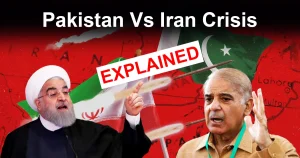Sweden, a country in Europe, has decided to join NATO, becoming the 32nd country to join NATO. This has been a surprising move as Sweden has long maintained a neutral position, staying away from these alliances. The leader of Sweden, Ulf Kristersson, went to Washington, D.C. to join hands.
But What Made Sweden to Join NATO?
Two years back, Sweden understood the need for the safety of their country after the Ukraine-Russia war started. Sweden wanted to join NATO in 2022, but some of the members of NATO, like Hungary and Turkey, were not sure to let Sweden in.
But after some talking and waiting, finally, all the members of NATO agreed that Sweden could join. The leader of NATO, Jens Stoltenberg, said it’s like having a new friend at their table. It makes the team stronger and everyone safer.
What is NATO?
NATO stands for North Atlantic Treaty Organization. It’s a peacetime military alliance where countries work together to keep everyone safe and help each other. The idea is that if one country is in trouble, all the others will come to help. It’s a way of making sure everyone is safe and strong together.
Why Was NATO Formed?
Founded on similar foundations, NATO was formed when some countries like the United States, Canada, and more joined hands as collective security forces against the Soviet Union.
The idea came after World War II when everyone wanted to make sure there wouldn’t be more wars.
The Three Purposes of NATO
Here are the three purposes of NATO:-
- Warning against Soviet Union expansion
- Stopping National Militarism in Europe
- Encouraging political integration among Western countries.
NATO has always kept doors open for European countries and its membership has increased from 12 to 32 countries through 10 rounds of enlargement since 1949. The “open door policy” is based on Article 10 of its founding Washington Treaty, and decisions are made by the North Atlantic Council through consensus. Its enlargement aims to promote stability and cooperation, making Europe whole and free.
How Many Countries Are in the NATO?
As of 7th March 2024, there are a total of 32 countries that have joined NATO. Let’s take you through the major events that contributed to what it is today:
- 1949: NATO was born! Belgium, Canada, Denmark, France, Iceland, Italy, Luxembourg, Netherlands, Norway, Portugal, the United Kingdom, and the United States with the first members.
- 1956: The Soviet Union and some of its friends formed their own group, making things a bit tense.
- 1949 –1989: The first three rounds of enlargement took place during the Cold War, while subsequent enlargements addressed the changing geopolitical landscape after the Cold War.
- The fall of the Berlin Wall in 1989 marked the end of the Cold War, leading to the reunification of Germany and the integration of new democracies in Central and Eastern Europe into NATO.
- 1995: Enlargement was debated in the early 1990s, leading to a study in 1995 to assess the benefits and potential impacts on Alliance cohesion and relations with other states, including Russia.
- 1997-1999: Czechia, Hungary, and Poland were invited to begin accession talks in 1997
- 1999: The Membership Action Plan (MAP) was launched in 1999 to help aspirant countries prepare for possible membership.
- 2008: The Bucharest Summit in 2008 addressed the future enlargement of the Alliance, including decisions related to countries in the Western Balkans. Georgia and Ukraine agreed to become members in the 2008 Bucharest Summit.
- 2010: Bosnia and Herzegovina was invited to join the Membership Action Plan (MAP) in April 2010.
What are the 32 Countries that are in NATO?
| S.no. | Countries | Year Joined NATO |
| 1. | Belgium | 1949 |
| 2. | Luxembourg | 1949 |
| 3. | Netherlands | 1949 |
| 4. | United Kingdom | 1949 |
| 5. | Iceland | 1949 |
| 6. | Denmark | 1949 |
| 7. | Norway | 1949 |
| 8. | Portugal | 1949 |
| 9. | Italy | 1949 |
| 10. | France | 1949 |
| 11. | United States | 1949 |
| 12. | Canada | 1949 |
| 13. | West Germany | 1955 |
| 14. | Greece | 1952 |
| 15. | Turkey | 1952 |
| 16. | Spain | 1982 |
| 17. | Czech Republic | 1999 |
| 18. | Poland | 1999 |
| 19. | Hungary | 1999 |
| 20. | Slovakia | 1999 |
| 21. | Bulgaria | 2004 |
| 22. | Estonia | 2004 |
| 23. | Latvia | 2004 |
| 24. | Lithuania | 2004 |
| 25. | Slovenia | 2004 |
| 26. | Albania | 2009 |
| 27. | Croatia | 2009 |
| 28. | North Macedonia | 2012 |
| 29. | Montenegro | 2017 |
| 30. | Romania | 2017 |
| 31. | Finland | 2023 |
| 32. | Sweden | 2024 |
Where is the NATO Headquarters?
NATO Headquarters is currently located at Boulevard Leopold III in Brussels, Belgium. In the beginning, it was based in London and later it was shifted to Paris in 1954.
NATO headquarters is not just known to be the political and administrative center of the Alliance, it is also home to many delegates. It is home to the senior political decision-making body, national delegations of member countries, and liaison offices or diplomatic missions of partner countries. Around 6,000 meetings take place at this headquarters every year.
What Does NATO Do?
NATO ensures the collective defense of its members and promotes stability and cooperation in the Euro-Atlantic area. Here are the key functions and activities of this alliance:
- Collective Defense: Its core principle is collective defense, as Article 5 of the NATO Treaty outlines. According to this, an attack against one or more members will be considered against all. Additionally, every member will be responsible for several necessary actions.
- Military Cooperation: It coordinates military efforts among its member countries to enhance interoperability and effectiveness. This includes joint training exercises, standardization of equipment and procedures, and the development of common doctrines.
- Crisis Management and Conflict Prevention: NATO engages in crisis management and conflict prevention through diplomatic and military means. This involves political dialogue, diplomacy, and, when necessary, military interventions to address and resolve conflicts.
- Partnerships: It builds partnerships with non-member countries and international organizations to promote security and stability. This includes cooperation with partner countries on military and security matters, as well as dialogue and collaboration with organizations like the United Nations and the European Union.
- Enlargement: NATO has expanded its membership through a series of enlargements, integrating new democracies into the alliance. This process is based on the principle that any European country meeting the criteria for membership and contributing to Euro-Atlantic security can join.
- Counterterrorism: It addresses security challenges related to terrorism by coordinating efforts among member countries, sharing intelligence, and conducting joint operations to counter terrorist threats.
- Cyber Defense: In response to the evolving importance of cybersecurity, NATO has developed capabilities to defend against cyber threats. The alliance recognizes the significance of cyber-attacks and works to enhance its ability to protect its networks and member countries from cyber threats.
- Strategic Airlift Capability: It provides a Strategic Airlift Capability (SAC) to enhance the alliance’s ability to rapidly deploy forces and equipment in response to crises or conflicts.
- Humanitarian Assistance and Disaster Relief: It caters to humanitarian crises and natural disasters by providing assistance and relief efforts. This may involve deploying military assets and capabilities to support civilian authorities in affected areas.
- Political Consultation: NATO serves as a forum for political consultation among its member countries. The North Atlantic Council, composed of ambassadors from each member nation, engages in regular discussions to address political and security issues.
How Many Nuclear Weapons Does NATO Have?
Power is one of the strongest ways to maintain safety. Having nuclear power, NATO prevents any aggression by creating a fear that the cost of any attack can be much more than the potential benefits.
As per a report shared by Statista Research Department on May 9, 2023, the three NATO allies (U.S. France, and U.K.) have nearly 4,223 nuclear warheads. Out of which the United States possesses 3,708 nuclear warheads.
Here are some key reasons why this peacetime alliance possesses nuclear weapons:
- Deterrence
- Alliance Cohesion
- Adaptation to Evolving Threats
Final Line
Sweden joining NATO is like a big change for the country. It shows that even if you’ve been doing things one way for a long time, sometimes it’s good to try something new, especially if it helps keep everyone safe and happy.
NATO plays a crucial role in ensuring the security and stability of its member countries, promoting cooperation and dialogue, and responding to a wide range of security challenges through military and diplomatic means.
Also Read About: Lok Sabha Election 2024: Who Will Win this Year?




